The United State Census Bureau has published an interactive map detailing United States migration patterns by county using net migration statistics from the American Community Survey. The map offers multiple year period datasets with the most recent data featuring 2015-2019, based on a data table of 593 counties. Selecting a county offers detailed data on the county’s net migration in relation to other counties during the selected period, including overall population and details on in-migrants’ previous locations and out-migrants’ final destinations. You can also select to look at just outbound or inbound migration to see strictly how many people are leaving or entering during the selected period.
Net migration in this dataset is defined as the inbound migration from the selected county subtracted from the outbound migration to the second county. Thus, a negative net migration means the county is losing population to the second county, while a positive net migration means the county is gaining population from the second county. Certain time periods allow one to choose a specific population characteristic, like sex, age, or even educational attainment and household income.
To understand this, let us select Walla Walla County’s net migration for the period of 2015-2019, the most recent period. The map shows that Walla Walla County is gaining population from Kitsap, King, Mason, and Challam counties, and losing population to Whatcom and Benton counties. A net total of 315 people moved from King County to Walla Walla County in this period. This may provide evidence for the ongoing trend of remote workers leaving major tech hub cities for smaller cities, as reported on in the Inlander in March of 2022. Selecting King County shows that the county is losing people to its surrounding counties, Snohomish County and Pierce County.
This data visualization allows for substantial exploration of county-to-county migration patterns. As stated, this exploration can include specific characteristics for the investigation of migration trends by sex, race, ethnicity, and more. These factors can tell us quite a bit about a county’s status and its political and economic climates. Probing this data may reveal many surprises if one is willing to dig deep enough.

